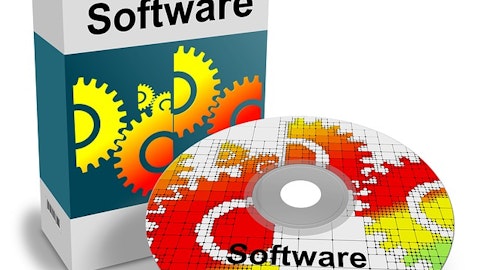Richard Danforth: Scott, I’ll do my best. If I forgot one of your questions, you’ll remind me. But the pipeline question, I mentioned in my remarks, it’s up 150% from this time last year, without consideration of the $25 million that’s also moved. So, if you put that in there, it would be even a higher pipeline opportunity for us. From a gross margin perspective, the fourth quarter gross margins were 49.6%, bringing the year to 46.6%. So, we saw a significant uptick. Q2 was 43.9%, Q3 was 46.9%, and Q4 was 49.6%. So historically, gross margin on our hardware business toggles plus or minus 50%, and we saw that in Q4. In terms of backlog, backlog going into fiscal year ’24 is down considerably from the backlog going into fiscal year ’23, which was reflective of the poor bookings in fiscal year 2023. Our revenue was ahead of our backlog, which means we paid — revenue was ahead of our bookings, which means we aid into a backlog.
Scott Searle : Okay. And then maybe moving over to the software side of the equation. It looks like you’re looking for sales to double this year conservatively. What clarification is Evertel built into that expectation? Because it seems like you’re seeing some early momentum on that front. And then what does Tablet Command and Ladris do in terms of the revenue opportunity in fiscal ’24?
Richard Danforth: All right. What was the first question? Tablet command?
Brian Alger: Evertel include.
Richard Danforth: Yes, Evertel is included in the remarks on expected annual growth of ARR and software revenue. Tablet Command is a co-sharing kind of thing. It’s not necessarily a revenue-generating relationship, as much as it is, we’re first responders using Tablet Command have access to our EVAC layer. Other firefighters in counties and cities and states will be able to see the utility of having that, and it will help enlighten them and get them interested in the Genasys Protect platform. So, you can think of that as more of a marketing kind of thing than a revenue-generating thing. Ladris is, in fact, a revenue-generating thing. So Ladris is an AI-driven platform for modeling, how to get a lot of people out of harm’s way in times of an emergency.
So, it allows a community or a large enterprise to set up scenarios and then run the model. If you needed to evacuate a large stadium, for example, and you’re using the existing road infrastructure, how long would it take for that stadium to be evacuated? Well, that might come back and say it’s going to take four hours, which is three hours too long. What the first responders can do in advance of this is then practice with, well, what if we shut down this road? What if we open that road up to two-way traffic or one-way traffic? And do all of that in advance of a catastrophic event. So, it’s a very useful utility, particularly when there’s a lot of people involved.
Scott Searle : So, Richard, will that be integrated into Evac then?
Richard Danforth: It’s separate right now, Scott. But over time, I would believe that we would integrate it.
Scott Searle : Okay. And then just on the opportunity pipeline, it seems like there have been a lot of inbounds. You look at things like Florida they got pushed out, but still kind of in that opportunity pipeline. It sounds like at record levels and the deal sizes are increasing. I’m wondering if you could provide a little bit more color in terms of what that translates to in terms of potential revenue or connected users? How should we be thinking about that?
Richard Danforth: I think I’ll go back to what I said, Scott, that we expect software revenue and ARR to double in this fiscal year. And there’s opportunities beyond that as well. But the pipeline is robust and the inbound opportunities, as you pointed out, is very good.
Scott Searle : Great. And lastly, if I could, the enterprise market, I think you announced something earlier this week in terms of some energy wins. I was wondering if you could specifically address that in terms of the interest level there, what you’re seeing kind of sales cycles, close rates? Are this kind of one-offs? Or is this something that we should expect to see more of in the future?
Richard Danforth: More in the future. So, a vertical we focus on is critical infrastructure protection. The orders you’re referencing are two nuclear power plants here in the United States. The order was — will — or the opportunity is for a total of four, two of which were booked and two more will likely book in our fiscal year 2025. But beyond that, we have in our forecast and pipeline power plants, large distribution centers. Anywhere there’s a lot of people, the utility of our hardware and software is realized.
Operator: And we’ll take our next question from Ed Woo from Ascendiant Capital. Please go ahead, Ed.
Ed Woo : Yes. Congratulations on the outlook for software. My question is on active shooting, it seems like there’s news every day about some active shooting somewhere in the U.S. Are you going to possibly focus on that? What are your opportunities in that area?
Richard Danforth: Our evacuation platform has been used in cases of active shooters. The Genasys Protect platform allows first responders to send emergency messages to very specific geographic areas. In fact, we just went live in the County of San Diego for that. The other thing it does, the CONNECT or the former Evertel, the CONNECT allows the first responders to be able to communicate privately, you mentioned active shooters at I think it was in the state of Maine, not too long ago, there was an active shooter situation. And I can tell you from my personal experience, I’m watching the national news, and the reporters on the national news are listening to HF radios and saying, “Oh, the active shooter must be in this town” and panics everybody in the area.



